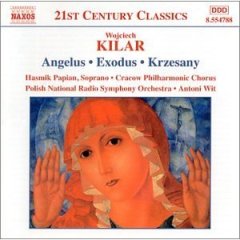Wojciech Kilar - Angelus; Exodus; Krzesany; Victoria (Antoni Wit) [1997]
Wojciech Kilar - Angelus; Exodus; Krzesany; Victoria (Antoni Wit) [1997]

1. Krzesany
2. Angelus
3. Exodus
4. Victoria
Hasmik Papian - soprano
Polish Radio Symphony Orchestra
Antoni Wit – conductor
Epic and fairly obvious music which will undoubtedly appeal to a wide audience. Great swathes of violent chromatics tumble down through the full orchestra in a burst of almost horrifying dissonance. Dramatic, if short-lived, stuff greatly enhanced by a hearty recording which reminds us just how spatial stereo sound can be. The Polish National RSO pack a hefty punch, with pugilistic brass and gloriously incisive strings. Antoni Wit Wrings every last gramme of excitement and drama from this supercharged score. Angelus and Exodus are extended choral works providing the Cracow singers with ample opportunities to blow away any remaining cobwebs; which they do with a vengeance. ---Marc Rochester, Gramophone, May 2002
Wojciech Kilar was born in the then Polish city of Lwów, now L’viv in Ukraine on 17th July, 1932. He studied piano and composition at the Katowice Academy from 1950 to 1955, then at the State Higher Music School in Kraków until 1958. In 1957 he attended the Darmstadt Summer School, and during 1959-60 was a pupil of Nadia Boulanger in Paris. In 1960 his Oda Béla Bartók in memoriam received the Lili Boulanger Foundation Award, the first of numerous prizes to come.
A prolific film composer, notably for such major Polish directors as Krysztof Zanussi and Andrzej Wajda, in the 1990s Kilar has found success in the West for his scores to Francis Ford Coppola’s Bram Stoker’s Dracula, for which he won an ASCAP award in 1993, Roman Polánski’s Death and the Maiden, and Jane Campion’s The Portrait of a Lady. After a period of experimentation in the 1960s, his concert work became notable for its directness of expression and immediacy of impact. Polish traditional sources, sacred and secular, are often prominent, in an idiom which, according to the writer Adrian Thomas, has "... been variously regarded as spuriously kitsch, naively devotional or intuitively post-modern".
Krzesany (1974), inspired by the Polish mountains, was Kilar’s first major success outside Poland, thanks in part to a recording by Witold Rowicki which enjoyed wide circulation in the West. Strings open with a passionate unison statement in chromatic, supplicatory harmonies. Dynamics quieten, lower strings sound a passive response, and a dance-like motion in the basses works its way towards a repeat of the opening bars, now on brass and strings. Three rapid downward glissandi across the orchestra lead to a ruminative theme on solo strings, then a general pause before a sequence of hammered unison orchestral chords. The music now drives forward in motoric rhythmic unisons on strings, with brass and percussion emerging to further the momentum. Calmer music on strings provides necessary respite, before the staggered unison orchestral approach to the work’s peroration, a raucous folk-like mêlée for strings, reinforced by shrill wind and clanging percussion. Held chords in the brass gradually break through the texture, at which point the work comes to a sudden, heart-stopping conclusion.
Angelus (1984) is a large-scale setting of the Ave Maria text. Muttered recitations, alternately for men’s and women’s voices, gradually increase in emotional and dynamic intensity. As the voices join in unison, a timpani roll leads to an outburst for chorus and orchestra around the words Jesus and Amen. A solo soprano enters in ecstatic strains, complemented by the chorus’ devotional restraint. Piano chords underpin a texture of Respighi-like richness, as the soprano continues her rapt meditation, the chorus echoing certain of her phrases as a brief climax, again on the name Jesus, is reached. As the vocal writing becomes more imploring, the music moves towards a fulsome outburst, cut off by a tam-tam stroke which returns soloist and chorus to their initial invocation. Strings and timpani provide the basis for the benedictory final section, in which the work’s emotional essence is brought to a noble apotheosis. These measured tones again build to a climax, which stops short, leaving the music to play itself out in a mood of beneficent calm. Over low strings, the opening recitation briefly returns, concluding with a hushed Amen.
Exodus (1981) is among the most striking of Kilar’s major choral works, thanks principally to its Boléro-like rhythmic momentum. A pulsating harp motion is joined by gradually coalescing fragments of a clarinet melody, strings entering to fill out the harmony and expand the emotional orbit. Tambourine adds an offbeat rhythm to the harp, while upper strings contribute a sumptuous cantilena to the texture. The clarinet theme is taken over by piano and solo strings, then the music descends through several harmonic planes, with the lower strings left to continue the main theme accompanied by deep left-hand piano chords. The texture gradually fills out once more, contracting rhythmically into a striding, march-like presentation of the theme in trumpets and trombones. These cede the foreground to upper strings, before the whole orchestra alights on the theme’s opening phrase, suddenly left sounding pensive in solo wind and strings. The latter drive the momentum forward, the march motion resumes, and the chorus enters with rapid-fire repetitions of biblical phrases. Domine is repeated with increasing fervour, and the main theme returns to cries of Alleluia. Chorus and orchestra unite for a martial statement of the main theme, the work ending in a mood of wild elation.
Victoria (1983) condenses this process into a short commemorative ode. A grandiose orchestral gesture launches the chorus in stirring, Orff-like music of military decisiveness. As the motion slackens, the words Deus dixit mark the return of the opening chords, bringing the piece full circle simply but effectively. ---Richard Whitehouse, naxos.com
download: uploaded anonfiles yandex 4shared solidfiles mediafire mega filecloudio nornar
Last Updated (Sunday, 29 December 2013 20:31)








